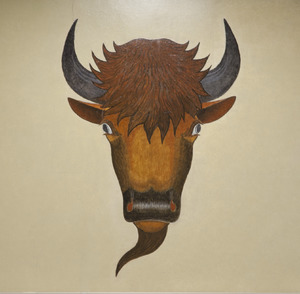Stephen Mopope facts for kids
Stephen Mopope (1898–1974) was a talented Kiowa artist, dancer, and Native American flute player from Oklahoma. He was a key member of a famous group of artists known as the Kiowa Six.
Contents
Early Life and Art Beginnings
Stephen Mopope was born on August 27, 1898, near the Redstone Baptist Mission on the Kiowa Reservation in Indian Territory. His Kiowa name was Qued Koi, which means "Painted Robe." His family had many artists. His great-uncles, Silver Horn and Oheltoint, were skilled artists. Oheltoint was one of the famous ledger artists from Fort Marion.
Even as a young child, Mopope loved to draw pictures in the sand. His family's artists taught him how to paint on animal hides in the traditional Kiowa way. His grandmother also helped a lot with his early learning.
In 1916, Mopope went to St. Patrick's Indian Mission School in Anadarko, Oklahoma. There, he learned more about art from Sister Olivia Taylor, a Choctaw nun. Later, a woman named Susan Peters helped arrange special painting classes for young Kiowa artists in Anadarko. She saw how talented Mopope and others were. Peters then convinced Oscar Jacobson, who led the art school at the University of Oklahoma, to accept these young Kiowa students into a special program.
The Kiowa Six Artists
Stephen Mopope was one of the artists in the famous group called the Kiowa Six. The other members were Spencer Asah, James Auchiah, Jack Hokeah, Lois Smoky, and Monroe Tsatoke. James Auchiah was the last artist to join the group at the University of Oklahoma in 1926.
In 1928, the Kiowa Six became known around the world. Their art was shown at the First International Art Exposition in Prague, Czechoslovakia. Dr. Jacobson helped their work be shown in many other countries. A special book called Kiowa Art, which had prints of their paintings, was also published in France.
Art Career and Other Talents
Stephen Mopope was asked to paint large pictures, called murals, in the US Department of the Interior building in Washington, D.C. He worked with five other Native American artists, including James Auchiah. Mopope's mural was very big, about 6 feet tall and 60 feet long. It showed a traditional Kiowa ceremonial dance.
He was also a member of the Native American Church. His paintings often mixed traditional ceremonial items with religious images. Besides being a great painter, Mopope was also a very skilled dancer and a wonderful flute player.
Mopope's art was featured in a big art show called Stretching the Canvas: Eight Decades of Native Painting. This show was held from 2019 to 2021 at the National Museum of the American Indian in New York.
Mopope's granddaughter, Vanessa Jennings, is also an artist. She is known for her beautiful Kiowa, Apache, and Pima beadwork and for making traditional clothing.
Where to See His Art
You can find Stephen Mopope's artwork in many public art collections, including:
- Anadarko City Museum
- Anadarko Community Library
- Bank of America Collection, Phoenix, Arizona
- Brigham City Museum of Art & History, Brigham City, Utah
- City of Anadarko
- Cleveland Museum of Art
- Dartmouth College Collection
- Fred Jones Jr. Museum of Art
- The George Gustav Heye Center
- Gilcrease Museum
- Heard Museum
- Indian Arts and Crafts Board, US Department of the Interior
- Mabee-Gerrer Museum of Art
- McNay Art Museum
- Museum of Northern Arizona, Katherine Harvey Collection
- Museum of New Mexico
- Millicent Rogers Museum
- National Gallery of Art
- Oklahoma Art Center
- Oklahoma Historical Society
- Oklahoma Museum of Natural History
- Oklahoma State Art Collection
- Oklahoma Science and Art Foundation, Gerrer Collection
- Peabody Essex Museum
- Philbrook Museum of Art
- Southwest Museum
- Seminole Public Library
- Smithsonian American Art Museum
- Southern Plains Indian Museum
- University of Oklahoma, Library
- Wheelwright Museum of the American Indian
- Woolaroc Museum
Later Life and Passing
Stephen Mopope passed away on February 2, 1974, in Fort Cobb, Oklahoma.


